RAIL Photography: PAUL BIGLAND
Ten years ago RAIL came up with a cunning plan to send me around the UK on an All Line Rover, to report on the state of the nation’s railways.
This year, for my biennial Rover journey, RAIL is sending me to retrace my steps from that first odyssey, and report on a decade of change. What has improved… and what has got worse? We’ll find out over the next three issues…
To get to my original starting point in London, I take Grand Central’s 0708 Halifax to King’s Cross, worked by one of the former First Great Western Class 180 Adelante diesel multiple units.
Ten years ago GC had its ambitions squashed by the Strategic Rail Authority, which had refused its application. Now it has two routes, and consistently receives high marks in Passenger Focus satisfaction surveys.
My train is busy in both Standard and First Class, as to many the connectivity it creates between the West Riding and London is a Godsend. It rather elegantly skewers the argument heard from some (in Yorkshire and elsewhere) that HS2’s fast links to London will act as a drain and damage the North’s economy.
The initial part of the route through Mirfield and Wakefield to Doncaster is a bit of a stagger, but on a beautiful sunny day like today I don’t mind - it gives me time to sip my coffee and enjoy the scenery.
After Doncaster the ‘180’ accelerates rapidly past the old Doncaster Carr locomotive depot (now being redeveloped for Intercity Express Programme trains), and we speed down the East Coast Main Line to London.
Arriving at King’s Cross, I don’t hang around. After answering some daft security questions to check my suitcase into left luggage (does anyone ever admit that someone has given them explosives to carry?) I go to buy a ticket.
But seeing the queues at the ‘Cross, I nip over to St Pancras International instead. Within a few minutes I have spent £478 of RAIL’s money on an All Line Rover, and head up to Crouch Hill to re-create that first journey.
The station has benefited from major improvements in a decade. Silverlink and the Class 150s have disappeared, and London Overground and Class 172s have taken over. The station is now staffed, and service frequencies have doubled.
I head to Barking on a half-empty train that trundles sedately across north and east London. The bright, clean interiors of the ‘170s’ are much nicer than the old ‘150s’, but they are too short a train in the peak. However, soon they’ll be gone, replaced by electric multiple units as the line will be electrified by 2017.
On arrival our Conductor makes his announcement in a mellifluous Deep South accent - the cadences are pure Gone With The Wind, reminding me what a melting pot London is. That impression is reinforced at the busy Barking station, where a constant flow of people of different races and nationalities weave in all directions.
I’m here to catch a c2c service out to Essex, via the Dagenham branch, and I don’t have to wait long before one of the company’s white painted Class 357s arrives to carry me to Grays.
At this time of day the service is pretty empty, but the train is clean and the trip gives me great views of HS1, which was still under construction back in 2004. I also keep a wary eye on the turbulent sky, which (when I change trains at Grays) looks more appropriate for Mordor than Essex!
Carrying on, I venture as far as Laindon, another improved station showing investment. A new station building opened in 2005, and I watch as Network Rail staff busy themselves putting the finishing touches to the new pointwork at Pitsea Junction, which has been totally replaced.
The old London, Tilbury and Southend Line has shaken off its ‘Misery Line’ tag. National Express has kept a franchise with consistent punctuality and a string of incremental improvements to stations. And now a new train fleet is to be ordered, to cope with expansion.
Retracing my steps, at West Ham I take my leave of c2c and head for the Jubilee Line to Stratford. Previously I used the North London Line service from North Woolwich, but this closed in December 2006 with the line becoming part of a vastly expanded Docklands Light Railway, while the trackbed further south is being absorbed into Crossrail.
East London has seen an explosion of rail development in the past decade, and Stratford station is almost unrecognisable - it has grown new platforms all over the place! In 2004 I would never have dreamed that it would be the main gateway to an Olympic Games park, or that the former railway works would have disappeared under a massive shopping complex, yet that’s what has happened. How times change…
Another change is the Abellio Greater Anglia Class 360 that takes me to Colchester. The ‘Michael Caine’ voice-making announcement has been replaced by women, with no audible trace of an Essex accent.
The train is busy, but I find a seat and observe the changes at the lineside. The most obvious investment in the Great Eastern Main Line is dozens of new overhead line equipment gantries, installed to improve reliability in an overhead system prone to failure in the past.
But as we pass Shenfield I spot something that hasn’t changed - an old ‘Shark’ ballast plough rotting away in the Up siding, where it has lain abandoned for more than a decade!
As we head further away from London I notice several new footbridges that have been installed to close off foot crossings, while at Marks Tey a new ticket office has appeared.
I change trains at Colchester, which has just had a £2.2 million revamp that involved re-opening the South side entrance, a new ticket office and extended canopies. I also note that all the signal heads have been replaced with new Dorman single/double lens ones, and that substantial track renewal has taken place.
No sooner have I scribbled down all my observations, than the 1523 arrives to carry me to Norwich. It is a busy service, despite the hour. Feeling peckish, I walk to the buffet and buy a BLT sandwich and coffee from a cheerful and smartly dressed young lady, then find a seat in coach D.
The coffee has certainly improved since 2004, as has the rolling stock. The ex-Virgin Mk 3s are a far better product than the tired Mk 2s they replaced, although they have their weaknesses. I use a Db meter to test noise levels, and watch the reading shoot all over the place.
All old coaches with droplight windows and unsealed gangways suffer from this, as external noise and air pressures penetrate the train. I’m not a fan of the fixed armrest IC70 seats either, and I find the lack of power sockets a nuisance.
We approach Ipswich under more Mordor skies. Then the rain starts, and it absolutely buckets down! There’s not much to see outside, so I decide to test the WiFi and pay £2.95 for access.
Logging on is straightforward and AGA’s front page is informative, but the railways have got themselves into a real mess over WiFi (see panel, page 54), with some train operating companies charging and others offering a free service.
While catching up on my emails, I am momentarily distracted when a well-dressed gent behind me answers his mobile phone and I overhear him say: “Oh, just leave it and ask them to get the chauffeur out.” It’s not a conversation I was expecting to overhear in Standard Class...
Arriving at Norwich, I take a break to enjoy the momentary sunshine and literally recharge my batteries, before catching East Midlands Trains’ 1754 to Peterborough (worked by 158785). The unit is clean, and although it is busy I am able to get a seat.
The line to Ely has been resignalled with axle counters and modular signalling, although the station at Wymondham still looks timeless and the signal box is intact. It’s easy to see the attractions of the lightweight, ‘plug and play’ modular signalling - the problem is when you plug and it doesn’t play, as my RAIL colleague Richard Clinnick (a commuter on the line) regularly finds!
Passing Thetford, an attractive floral display and boarded up signalbox catches my eye. A few minutes later, a squadron of pigeons narrowly misses becoming kamikazes - they evade the ‘158’ at the last moment by curving away into a wheat field.
I have headed back into stormy weather, with a black sky ahead and a rainstorm sweeping by to my right. It’s lovely to watch from the comfort and warmth of my train.
As we swing left into Ely we pass the towering cathedral and cross the Great Ouse river, packed with pleasure craft of all shapes and sizes. The station is a busy and attractive place, festooned with planters that cascade a cornucopia of colour across the platforms.
After a reversal we head for Peterborough, running through what looks like fields of leeks and masses of potatoes. Ironically, despite the weather, farmers are busy watering their crops!
We make a brief stop at March station. Although most of the buildings are unused, it looks well maintained with all the woodwork recently repainted in grey gloss.
Racing on to Peterborough, we pull into a platform that never even existed ten years ago. And the bottleneck I wrote about then has gone. Network Rail has spent £43 million on new platforms, tracks, signalling and passenger facilities. I hardly recognise the place!
Sadly, I don’t have time to explore, so after grabbing a few photos I board First Capital Connect’s 1946 to King’s Cross, formed of a pair of Class 365s. It is a quiet train that had arrived as a busy 12-car.
I like these units. They are the best of the late British Rail EMUs, and I only hope that when their day is done here, they’re cascaded to the North West.
The weather makes for a dull, grey journey back to London, although I am kept amused watching a young woman opposite using her mobile to take ‘selfies’ to do her make-up.
Back in London, it’s time to call it a day. But what a place to end it - King’s Cross. The station has had a £550m revamp, taking it out from under the shadow of its flamboyant neighbour, St Pancras.
I love the sense of space and design of the new Western concourse, and I celebrate the end of day 1 with a pint in the restored Parcel Yard pub, before heading to my hotel and bed.
Day 2
Day 2 begins at Caledonian Road & Barnesbury, on the former North London Line. This station has been extensively rebuilt as part of the London Overground, a scheme that has transformed what was a vital but neglected London artery.
I catch the 0845, which is hot, humid and heaving with people. It may be an air-conditioning fault, but they’re not normally that sweaty.
At Willesden Junction I change for a train to Clapham Junction. London Overground is a great success story. It has turned around Cinderella lines, introduced new high-capacity trains, enhanced timetables, modernised and staffed stations, and achieved impressive levels of punctuality. It has been a very positive decade of change.
Clapham Junction hasn’t stood still either. As well as new Overground platforms, the old footbridge has been refurbished with better waiting areas, more stairs and new lifts. And canopies have appeared on platforms that used to be open to the elements.
Moving on, I catch a comfortable and quiet Class 450 to Woking, where I change for the ‘Pompey’ line. The station remains much the same as I remember it a decade ago, although the old Yew Tree cafe is now a more upmarket Starbucks.
I am surprised to find a catering service on the train, although there is nearly a nasty accident when the trolley ploughs into the arm of the seat in front, nearly sending a wave of coffee over my camera, which is perched on the seat’s back table. This is ironic - ten years ago I commented on nearly wearing coffee owing to the Mk 1 EMU’s ride quality.
At Guildford we are held at for a few minutes, but the Guard uses the PA to apologise and explain this is due to signal failure, and we leave five and a quarter minutes late.
At Petersfield a pair of roving Revenue Protection Inspectors join, and I listen in as they swap stories of fare dodgers’ dodges!
The late running worries me, because I am hoping to catch the Isle of Wight ferry. Fortunately, I make it with minutes to spare and enjoy a sunny trip across the Solent, before disembarking at Ryde pier for a trip on a timewarp railway running 75-year-old ex-London Transport Tube trains!
Despite the age of the stock, the IoW Railway has moved forward, and as we bounce and rattle our way from Ryde to Shanklin I can see improvements. Life has returned to many of the stations. There are new cafes and shops, artwork and gardens. On my return I stop off at Brading station, which has re-opened as a heritage centre. The Island Line is a credit to the energy of the community and the local Community Rail Partnership Officer, Bobby Lock.
I wish I could stay longer, but time is of the essence. Soon I am back on the mainland, heading for Gatwick on Southern’s 1515 Portsmouth-Gatwick Airport formed of a clean, well-presented Electrostar.
There is a prompt ticket check, although the guard doesn’t have much to do because the train is quiet, with only eight passengers in my car. Well, quiet apart from a teenager who chatters 19 to the dozen to his female companion. Time to reach for the iPod!
The journey via the picturesque Arun Valley is gorgeous. The route is the epitome of Englishness, with picture postcard views and properties straight from the pages of Homes & Gardens magazine. The only change is that the line has been resignalled, all the distinctive Southern semaphore has gone, and the signal boxes have been closed. It’s a necessary progress, but the line has lost some of its charm.
At Horsham we join onto the rear of another train. The move is accomplished with little fuss, and takes mere minutes.
At Three Bridges (where a new Thameslink depot is taking shape) we join the Brighton Main Line. I change trains at Gatwick
Airport and catch the 1705 Gatwick Airport-London Victoria, worked by two ex-South West Trains Class 442s.
Compared with a decade ago, this really is a retrograde step. The ‘442s’ are inferior to the bespoke Class 460s they have replaced - their narrow doorways are far too restrictive for airline passengers laden with luggage. That said, the train is quiet and the journey comfortable.
Back in London, I attempt to re-create my 2004 trip on the South London metro services. It’s impossible to repeat the original itinerary, as platform extensions at Battersea Park have closed the junction used by the Victoria-London Bridge via Denmark Hill service. So I retrace my steps to Clapham Junction and catch an Overground service out to Peckham Rye.
The change is amazing compared with 2004. Then the lineside was thick with graffiti, and the state of the former Connex stock was appalling. The train windows of the Class 456s working the route used to be so badly etched with graffiti it was almost impossible to see out of them.
Now Connex is history, window etching has become a minor problem, and even the graffiti is far less in evidence than it used to be. The only thing that is worse is the buddleia, which threatens to overwhelm some viaducts along the line, turning them into hanging gardens and causing untold damage. That aside, there’s no doubt of the improvements to be seen.
I stay in Peckham long enough to change trains, and head back to Clapham to end the day with friends.
In RAIL 758, Paul heads west to Wales and north to Scotland.
- This feature was published in RAIL 757 on 17 September 2014
Read All-Line Rail Rover Part 2 and All Line-Rail Rover Part 3.

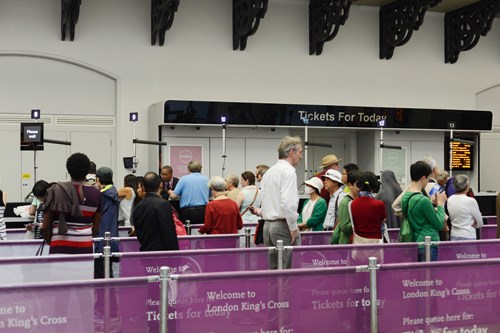
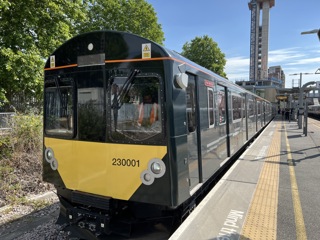
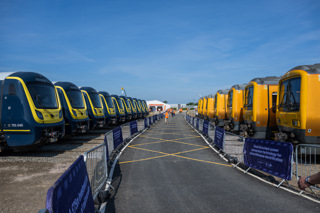
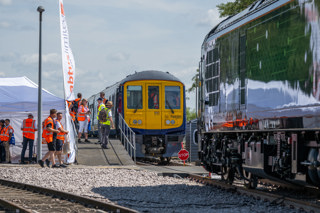
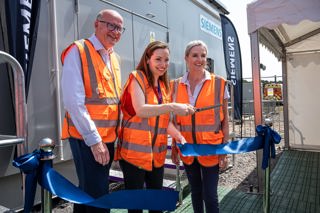
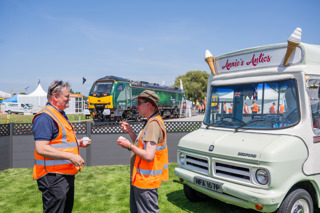











Login to comment
Comments
No comments have been made yet.